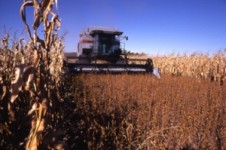Shifting Fields

The US had its best soybean producing season on record in 2006, according to the Crop Production 2006 Summary released by the US Department of Agriculture’s National Agricultural Statistics Service (USDA-NASS).
The 3.19 billion bushel soybean crop was 2% larger than the previous record set in 2004 and 4% larger than 2005. Nationwide, the harvested area was up 5% from 2005, to 74.6 million acres.
Why then are US farmers looking at doing away with soybean acreage this year? The answer: ethanol. Ethanol manufacturing plants in the US are popping up even faster than the soybean crop did last year, and the promise of good prices is too tempting for many US growers to resist. Currently, acreage estimates range from 6 million to 9 million more corn acres compared to 2006, many of which would be coming away from the soybean crop.
Already, corn seed companies are feeling the effects. Interviewed by FCI’s sister magazine, CropLife, Doug Gloystein, general manager of NC+ Hybrids, Inc., said, “We are expecting customer demand for triple-trait seed corn to increase by more than five-fold in 2007.” And Carl Casale, executive vice president for Monsanto’s North America commercial business, added that “The early order activity for our triple-stack products is unprecedented.”
All that corn area is going to come from somewhere, meaning that soybeans are likely to be reined in this year. While some growers will change their crop rotations, possibly growing corn for a second straight year, Barry Ward, an Extension economist from The Ohio State University, US, said, “Most growers are not taking the big plunge from soybeans straight into corn. Many are just rolling a small percentage of their soybean acreage, 5% to 25%, into corn production.”
For crop protection products and fertilizer, any move from soybeans to corn will create additional value.
Ripple Effect
If US cutbacks on soybeans are significant, there could be several outcomes. The most optimistic of these would be an increase in the international price for soybeans as supplies shrink, which would be welcomed by growers and distributors alike – especially considering the current low levels of soybean stocks.
In the EU25, the production of soybeans slightly increased thanks to a combination of a larger planted area and higher than expected yields. Soybeans are not a very important crop in the EU; the area planted with soybeans is only about 6% of the area planted with canola and 15% of the area planted with sunflowers.
The bright spots in the EU could be the areas in which biodiesel is produced. For many years, soybean oil has been used to make biodiesel in Italy, and it has been used in increasing amounts in Spain, Portugal, Slovenia, and Greece, as well as in France and Germany. This explains the strong price rise in soybean oil in northern Europe since April.
The major South American soybean producers stand to make major gains with any improvement in soybean prices. While the vast majority of the crop in South America is glyphosate resistant, fungicides still present great opportunities, particularly if prices are strong enough for growers to justify the cost of multiple sprayings. The improving agricultural economy in Brazil could help the country recover from its downturn, leading to better production, although some of the land planted to soybeans has been shifted to other crops.
Technology On Deck
Several new technologies are emerging on the soybean front, including beneficial traits and new products with multiple modes of action to help curtail weed resistance.
- DuPont and Bunge have completed the US regulatory submission for their high oleic soybean trait, keeping the product on track for commercialization by 2009. The “next generation” healthy oil, low trans fat trait developed by DuPont through its subsidiary Pioneer Hi-Bred International, Inc. in a partnership with Bunge will provide benefits to food processors and industrial customers better than other low linolenic soybean oils on the market, according to DuPont.
- Monsanto Co. and Divergence, Inc. announced an extension to their collaboration agreement to develop nematode-resistant soybeans. The two companies initiated their relationship in 2004 and recently extended the collaboration, which uses technology from both companies to research and develop in-seed nematode protection for soybeans.
- FMC Corp.’s new dual-mode Authority First DF herbicide for soybeans is available for the control of resistant weeds through the dual modes of action of sulfentrazone from FMC and cloransulam-methyl from Dow AgroSciences. Authority First is available in a dry flowable formulation for preemergence use to control a wide spectrum of problem weeds, including glyphosate-resistant broadleaf weeds.
- On the other side of that coin, Dow’s Sonic, also a premix of Dow’s cloransulam-methyl and FMC’s sulfentrazone, is available for use on soybeans, including as a preemerge treatment in Roundup Ready systems.
- DuPont’s Optimum GAT trait completed US regulatory submissions and could be available by 2009, according to the company. The trait will offer growers opportunities to improve crop safety and yield potential, among other benefits.





